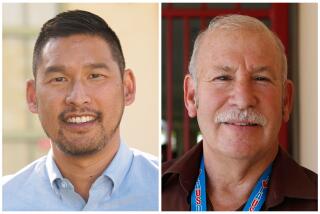Battle Lines Drawn in School Voucher Fight
- Share via
With less than five months before the November election, forces on both sides of the controversial school choice initiative are gearing up for what is expected to be a bitter and bruising campaign.
The pro-voucher forces will try to turn the election into a referendum on the state’s public schools and make the stumbling Los Angeles Unified School District--the state’s largest--a centerpiece of that campaign.
Opponents will portray the initiative as a threat to a basic democratic belief in public education as the great equalizer and will hit hard at the fact that tax money would go to private and parochial schools.
Surprised by Gov. Pete Wilson’s announcement Thursday that the measure will go before voters in November--seven months ahead of schedule--both sides kicked their fund-raising campaigns into high gear Friday in their bids to sway voters.
A poll taken by The Times in March showed 51% of Californians oppose the voucher plan while 41% support it.
But almost half the parents polled--49% compared to 36% of non-parents--said they support the idea of vouchers. The initiative’s backers hope to lure voters to the polls with a campaign that taps into dissatisfaction with public schools.
“People are unhappy with the status quo, and we will emphasize to them that without vouchers any movement to change the status quo will stop the day after the election and it will again be business as usual,” said Kevin Teasley of the Choice in Education League, which is sponsoring the ballot measure.
Rosemarie Avila, a school board member in Santa Ana and one of a minority of public-school officials who favors the voucher initiative, said the measure would “improve the system by having more competition, more accountability.”
Avila also said she believes the troubles in the Los Angeles Unified School District this year will help persuade voters that the time has come for profound change in the way schools are managed.
Sherry Loofbourrow, a school board member in Newport-Mesa Unified and also president-elect of the California School Boards Assn., she said worries that voters might equate Los Angeles Unified with “all of public education in California,” and conclude that the voucher initiative is needed to solve all the schools’ problems. But Loofbourrow said she still has faith that once voters understand the measure, they will defeat it.
“It would take much-needed funds away from public schools and channel them into a system where there is no accountability,” she said.
The initiative would allow parents to take public tax money, in the form of a voucher worth about $2,500, to pay tuition at private or parochial schools. The scholarships would cut into the amount the state spends on public schools.
Teasley said the measure’s proponents will portray school choice through vouchers as a way to “level the playing field” and create a better balance between the interests of parents and those of the powerful labor unions that now influence school district management.
Mindful of Teasley’s tack, California Teachers Assn. President Del Weber said his group will focus on persuading voters that teachers have been the agents of reform and not its stumbling blocks.
“It’s easy to accuse us of being against reform, but we’ve supported every reform movement that has come down the pike and we have to get that message across to the public,” he said.
The giant Los Angeles district will probably provide the pro-voucher forces with a vivid example of all that can go wrong with public education.
Observers believe that the advanced election date may aid pro-voucher forces because it enables them to wage their campaign at what is probably the worst time in recent history for the 640,000-student system.
The district, the nation’s second largest, is embroiled in labor problems, faces mounting accusations of mismanagement and is entering another year of grueling budget cuts that will further erode already lean programs and services.
A study by the CTA shows that a huge percentage of the likely voters on the voucher issue live in the Los Angeles area and will probably be influenced by the district’s well-publicized problems.
In the face of rising campus violence, a move to dismantle the district and an ongoing struggle to remain solvent, the district’s ability to persuade voters that public schools can deliver may emerge as a key issue in the campaign.
“It’s not surprising that they would pick Los Angeles as the target for this issue,” said school board President Leticia Quezada. “But I don’t think the effort depends on what we do to immediately turn around the image of this district. That’s going to take a lot more than the five months we have between now and November.”
Allan Odden, USC education professor and co-director of Policy Analysis for California Education, a university-based think tank, said the “instability and lack of faith in Los Angeles Unified might initially make people feel positive toward a voucher system.”
But he believes that the Los Angeles district’s troubles ultimately will not be enough to carry the day for voucher proponents.
“The bottom-line question is: Do people think a voucher will buy them a good education?” he said. “When somebody looks at the price and the fiscal reality--that you just can’t buy much for $2,500--the answer is going to be no.”
In addition, many high-quality private schools are far costlier and are already full, he said, putting them beyond the reach of most families with children in public schools.
Finally, voter dissatisfaction with public schools may be canceled by a strong aversion to spending tax money on private school tuition, especially at religious institutions, the largest chunk of the broad spectrum of non-public education, Odden said.
Odden predicted that the voucher initiative would pass only “if it becomes a big protest vote” against public education.
More to Read
Sign up for Essential California
The most important California stories and recommendations in your inbox every morning.
You may occasionally receive promotional content from the Los Angeles Times.











